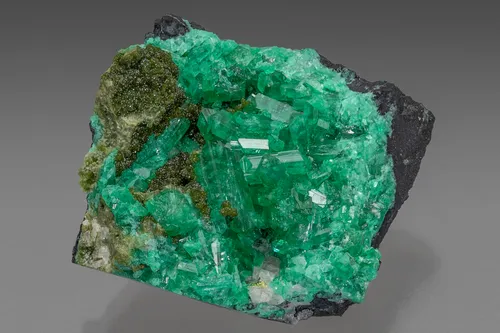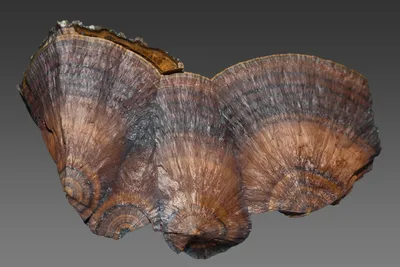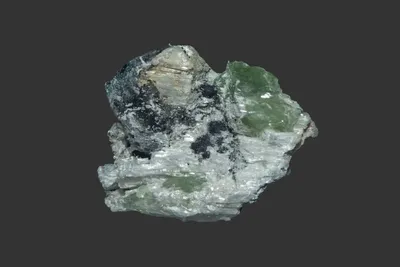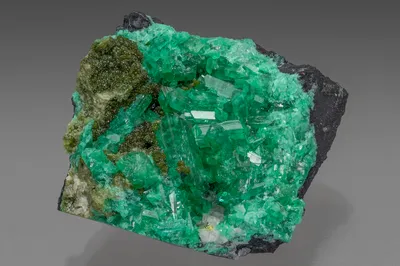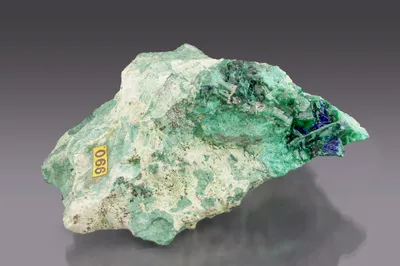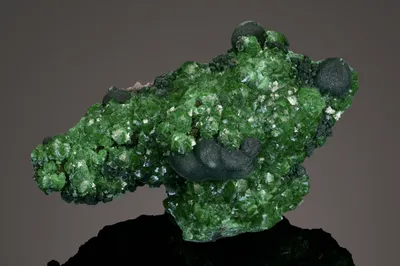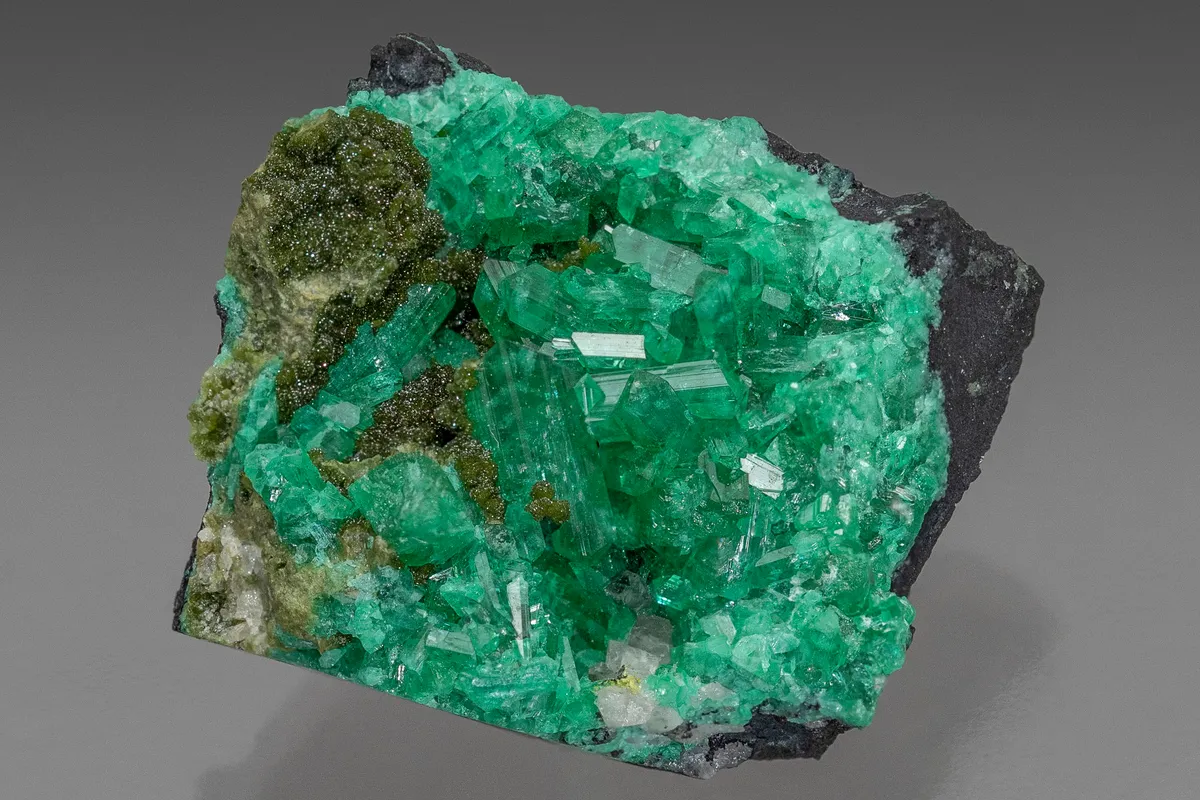
Image Credit: Malcolm Southwood
Mineral Species
Zincolivenite
Type Locality
No
Composition
CuZn(AsO4)(OH)
Crystal System
Orthorhombic
Status at Tsumeb
Confirmed
Abundance
Common
Distribution
First, second and third oxidation zones
Paragenesis
Supergene
Entry Number
Species; TSNB382
General Notes
Zincolivenite is a relatively new species name (Chukanov et al. 2007) describing intermediate members of the adamite-olivenite series with a Zn:Cu ratio of between 75:25 and 25:75. For practical purposes, the vast majority of intermediates that have hitherto been known by the informal (and now discredited) name "cuproadamite", fall within the compositional range of zincolivenite (Southwood et al. 2020).
The three discoveries of zincolivenite listed here were recorded as "cuproadamite" in the references cited:
- In the second oxidation zone, Key (1977) recalled a major discovery on 28 level, in c. 1973/74, that yielded a variety of arsenates including a complete gradation "between cuproadamite and zincian olivenite", of which most spectacular were dark olive green, blocky crystals to 35 mm, and prismatic emerald-green crystals with schultenite.
- The 1986 pocket of cuprian adamite on bright yellow ferrilotharmeyerite from 30 level in the second oxidation zone (see Gebhard 1999; Cairncross 2000) was arguably one of the most spectacular finds.
- In the third oxidation zone, sharp, bright-green crystals of zincolivenite with mustard-yellow ferrilotharmeyerite were found on 43 and 44 levels. (See also notes on adamite and olivenite.)
Olivenite was recognised very early in Tsumeb’s history. Maucher (1908a) and Klein (1938) considered it very common in the upper portion of the first oxidation zone, between the surface and 4 Level. None of the pre-WWII authors, however, appear to have recognised the occurrence of adamite. Both adamite and the intermediate species, now known as zincolivenite, are somewhat rare in the first oxidation zone but although specimens of zincolivenite are conserved in pre-WWII collections, they appear to have been misunderstood. For example, specimens now confirmed as zincolivenite in the Klein and Karabacek collections at Harvard University were erroneously identified as tsumebite (Klein; MGMH 106018) and veszelyite (Karabacek; MGMH 93856); the status of zincolivenite as a copper-rich adamite (or a zinc-rich olivenite) does not appear to have been recognised at that time. Maucher (1908a), however, recognised that some olivenites from Tsumeb were zinc-rich, and that the zinc content affected colour and habit.
The first mention of adamite from Tsumeb in the formal literature is by Strunz et al. (1958a). Their list of minerals from the first oxidation zone includes "Olivenite Cu2[OH/AsO4]–Adamite Zn2[OH/AsO4] (Isomorphic)", suggesting that they recognized the presence of different compositions within the solid-solution series. For the second oxidation zone, however, they list "Olivenite (epidote-green), Adamite (yellow-brown), and their mixed crystals (blue-green to brown)" indicating for the first time, the identification of something they believed to be close to end-member adamite and a growing understanding, perhaps, of the relationships of intermediate compositions in the solid-solution series.
Strunz (1959) described an occurrence of "cuproadamite" from 30 level in the second oxidation zone. He presented crystallographic drawings, unit cell parameters, and optical data, suggesting that the occurrence was considered a significant novelty. As mining progressed through the second oxidation zone, however, discoveries of "cuproadamite" became relatively common (Geier 1973/74).
Bartelke (1976) noted the rarity of end-member adamite but the relative abundance of bright green cuproadamite with varying proportions of zinc and copper that sometimes manifest as colour zoning. He described crystals with rhombic, pseudo-octahedral, and prismatic habits.
Pinch and Wilson (1977) commented on the rarity of "copper-free adamite" at Tsumeb, and their description of cuproadamite as "… supposedly part of a continuous series to olivenite" indicates a continuing uncertainty as to the nature and status of the more common copper-bearing members of the series.
Keller (1977a) made a study of second oxidation zone parageneses and concluded that "cupriferous adamite" is more common (in the second oxidation zone) than olivenite and that it occurs in more complex associations. Keller identified 19 secondary minerals that occur with "cupriferous adamite" compared with only nine for olivenite.
Southwood et al. (2020) analysed 43 specimens of adamite – olivenite series minerals by wavelength dispersive spectroscopy, selected to cover as wide a range of colours and habits as possible. Virtually all specimens with a colour and habit that would have led to their being labelled as "cuproadamite" turned out to have a composition consistent with zincolivenite. The only notable exceptions to this were zoned crystals which included either zincolivenite plus adamite, or zincolivenite plus olivenite.
The habit of individual zincolivenite crystals varies from equant or tabular, sometimes pseudo-octahedral, to slender prismatic. The terminations of prismatic crystals are commonly chisel-shaped. Radial intergrowths of crystals are quite common. The colour of Tsumeb zincolivenite ranges from spearmint-green, through emerald-green to bottle-green; the lighter hues are typical of compositions towards the adamite (Zn-dominant) end of the series, while the darker green crystals are typically copper-dominant and approaching olivenite in composition. The lustre is usually vitreous and the crystals are typically translucent, although smaller crystals may be transparent and gemmy.
Colour may vary considerably within a single crystal and is often indicative of compositional zoning. To the extent that such zoning involves other species, adamite and olivenite are the most commonly encountered. However, zincolivenite crystals with cores of chudobaite, ferrilotharmeyerite or johillerite have also been reported (Gebhard 1999).
Minerals of the adamite-olivenite series were considered by Keller (1977a) to belong to "Type II" parageneses (i.e. mineral sequences forming at lower pH ranges). Zinc-rich members of the adamite-olivenite series were reported to have a wider range of associated secondary minerals than copper-rich members. Keller included "adamite" in three of his Type II parageneses, but his textual references to "cupriferous adamite" permit the inference that he was referring to the composition now defined as zincolivenite:
II/4: primary sulphides >> conichalcite >> adamite [= zincolivenite] >> schultenite (or chudobaite)
II/5: primary sulphides >> conichalcite >> adamite [= zincolivenite] >> azurite >> malachite
II/6: primary sulphides >> conichalcite >> tsumcorite >> adamite [= zincolivenite] >> smithsonite.
Some of Tsumeb's very rare and extremely rare arsenates occur in association with zincolivenite which led Gebhard (1999) to recommend that specimens should be carefully scrutinised for other species.
Associated Minerals
adamite; andyrobertsite; azurite; bayldonite; calcioandyrobertsite; calcite; cerussite; chalcocite; chenevixite; claudetite (?); conichalcite; chudobaite; davidlloydite; dolomite; duftite; erikapohlite; eugenite; fahleite; ferrilotharmeyerite; gaitite; gartrellite; geminite; goethite; gypsum; helmutwinklerite; hematite; hörnesite; johillerite; keyite; koritnigite; köttigite; lavendulan; lepidocrocite (?); lindackerite; ludlockite; lukrahnite; malachite; metazeunerite; mimetite; o’danielite; olivenite; philipsbornite; prosperite; quartz; reinerite; rosasite; schultenite; silver; smithsonite; spertiniite; stranskiite; tennantite-(Zn); tsumcorite; warikahnite; willemite; wulfenite; zincgartrellite
